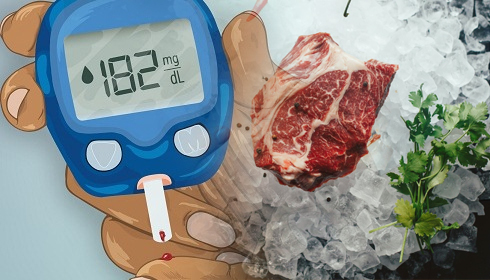
People getting their iron supplement from meat had a 26% higher risk of Type 2 diabetes, finds study
Heme iron, mostly present in red meat and other animal products, has a notable correlation, according to a new study from the Harvard T.H. Chan School of Public Health, with a higher risk of type 2 diabetes (T2D) as much as 26% than those who do not have. The upcoming study, to be published in Nature Metabolism, provides a more complete understanding of this link by looking at both the molecular and epidemiological processes under influence.
The body easily absorbs iron, which has long been considered a contributing factor to T2D risk, and this study provides a fresh understanding of the degree of influence. Examining people’s intake of several kinds of iron—including heme, non-heme, found in plant-based foods, and supplemental iron—the researchers used 36 years of dietary data from almost 206,000 individuals. They discovered that those with the highest heme iron intake had a 26% higher risk of T2D than those with the lowest intake.
Emphasising the strength of the study's results, lead author Fenglei Wang said, "We integrated multiple layers of information, including epidemiological data and cutting-edge metabolomics, to gain a more comprehensive understanding of the association between iron intake and T2D risk." This method lets the scientists identify particular metabolic channels through which heme iron might affect T2D development.
Fascinatingly, the study revealed no appreciable correlation between non-heme iron, derived from plant-based foods, and T2D risk, underscoring the special contribution heme iron makes to the disease's development. This difference raises important nutritional advice issues, particularly with regard to the growing popularity of plant-based meat substitutes, which often include additional ingredients to replicate the taste and texture of real meat.
Examining plasma metabolic indicators in smaller subsets of subjects, the study team also investigated the molecular processes behind this relationship. They found a connection between higher heme iron intake and negative metabolic profiles, such as elevated levels of C-peptide, lipids, and inflammatory markers like C-reactive protein. These biomarkers significantly correlate with the development and course of T2D.
Furthermore, the study identified numerous blood metabolites, such as uric acid, L-valine, and L-lysine, which could potentially explain the correlation between heme iron intake and T2D risk. Previous links between these metabolites and the disease further corroborate the research's findings.
This study has broad consequences, especially for public health policies meant to lower the prevalence of diabetes. To minimize T2D risk, the researchers recommend a more plant-based diet and a reduction in iron intake from red meat. Though the present study sample was mostly white, they warn that more research is required to verify these conclusions across many racial and cultural groups.
Frank Hu, the study's corresponding author, emphasised the importance of dietary decisions in diabetes prevention, stating, "Reducing iron intake, particularly from red meat, and adopting a more plant-based diet can be effective strategies in lowering diabetes risk."
Notwithstanding its advantages, the study has many limits, including possible confusing elements and measurement mistakes in the epidemiology data. Still, the results provide important new information for the current conversation on nutrition and diabetes, urging a review of present dietary recommendations.